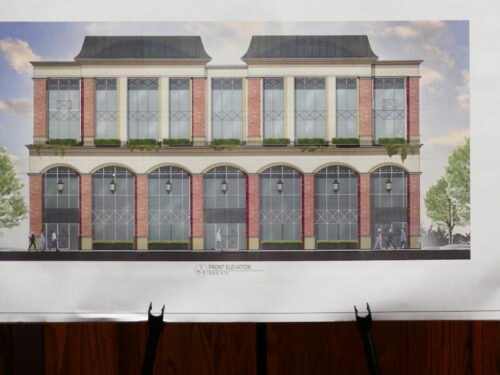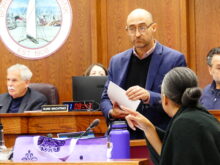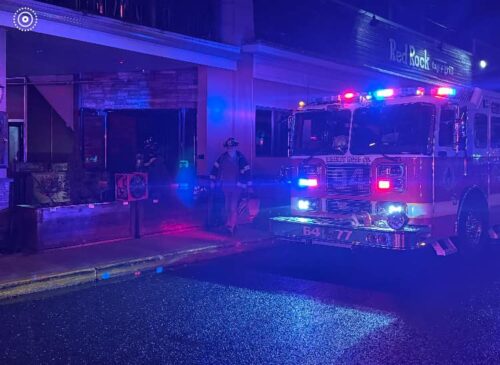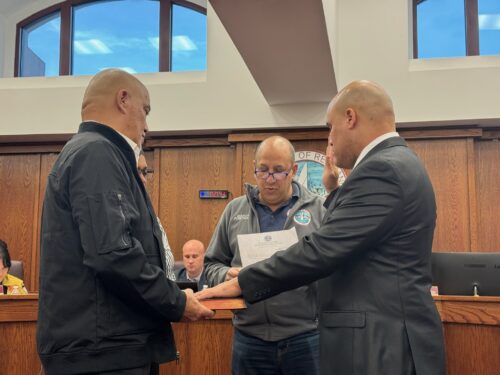 A rendering of the Bridge Avenue facade of the building, which would feature a public space formed by a colonade. (Photo by Michael James Monroe. Click to enlarge.)
A rendering of the Bridge Avenue facade of the building, which would feature a public space formed by a colonade. (Photo by Michael James Monroe. Click to enlarge.)
By JOHN T. WARD
A long-delayed hearing on a proposed new apartment complex at the Red Bank train station turned out to be a feedback-gathering session for the architect last week.
And the first round of feedback turned out to be “it’s way too big” and “pretty ugly,” to boot.
 Architect Michael James Monroe detailing the Oakland Street side of the proposed project. Below, Anthony Setaro, who owns a house that would face that side. (Photos by John T. Ward. Click to enlarge.)
Architect Michael James Monroe detailing the Oakland Street side of the proposed project. Below, Anthony Setaro, who owns a house that would face that side. (Photos by John T. Ward. Click to enlarge.)
 At 49 feet tall, and providing ground-level parking for 47 vehicles, the project centered on 78 Bridge Avenue does not need height or parking variances, according to attorney and former mayor Ed McKenna, representing the applicant, American Opportunity Zone Fund LLC, owned by Warren Diamond of Rumson.
At 49 feet tall, and providing ground-level parking for 47 vehicles, the project centered on 78 Bridge Avenue does not need height or parking variances, according to attorney and former mayor Ed McKenna, representing the applicant, American Opportunity Zone Fund LLC, owned by Warren Diamond of Rumson.
Still, architect Michael James Monroe drew fire from neighbors and board members for the scale of the proposed 32-unit building, which would front on Bridge and sweep around an existing corner building to Oakland Street.
The plan calls for the demolition of two Victorian-style houses on Oakland, and a string of three commercial structures on Bridge, including the one that houses Mi Lupitas restaurant and another that contains an art gallery.
Among the features of the proposed building: a colonaded portico that faces the train station and serves as a 12-foot-deep “public space,” said Monroe. For residents, there would be a green roof and a pickleball court.
But the court, the building’s scale, and the 35-units-per-acre density offered little for commenters to like.
The 175-foot-long Oakland Street side of the building, featuring a garage access and three stories of windows above, also appeared none too popular. Board chairman Ray Mass called it “pretty ugly.”
Monroe repeatedly said he was open to suggestions on the plans. But building more than the 20 units permitted by zoning would mean more set aside for low- and moderate-income earners, he said – five, instead of two, he said. At the permitted density, the apartments would also be larger, and thus more expensive to renters, he said.
“Part of the density thing is not just to make them more affordable,” said Monroe. “In my reading of the transit overlay [zone], it’s right next to the train station, it’s a textbook example… It’s a good location to have more units because it gets people closer to transportation.”
Commenters were blunt in their critiques.
“I feel the building is too dense,” said board member Paul Cagno. “It’s towering… I don’t think it matches the area.”
“I don’t mind making it comply,” Monroe replied.
“It’s just too much of a building for that area,” which would lose “two perfectly good” houses if allowed, said Scott Wenning, of Shrewsbury Avenue. “And nobody wants a pickleball court on the roof.”
Board member Ben Yuro, though, favored the higher density, for its ability to create more housing units. Chris Havens noted that larger apartments would cost more per month per tenant, and suggested the applicant tell the board the minimum number of units needed to make the project work.
The site is kittycorner from the 57-unit Rail project built by Denholtz Properties and opened in 2022.
Nearby homeowners sought to distinguish the area from the Rail’s neighborhood. For one thing, the Rail doesn’t abut any other residential properties, some said.
Anthony Setaro, who co-owns a family homestead on Oakland, detailed his research into the area as the historical heart of an “Italian colony” in Red Bank.
The four-story structure would be “engulfing and swallowing” a century-old two-story building at the corner of Oakland and Bridge that is not part of the project, Setaro said.
McKenna said the developer would resubmit plans, but did not say when. Property owners within a 200-foot radius would be notified in advance of the next hearing, he said.
The hearing, originally scheduled to begin in May, was repeatedly rescheduled until last week, when it finally got underway. But even then, Monroe was the only witness on behalf of the applicant.
McKenna cited illnesses and other issues for the delays, and said other experts a planner, an engineer and a traffic consultant, would testify at a future date.
Do you value the news coverage provided by redbankgreen? Please become a financial supporter if you haven’t already. Click here to set your own level of monthly or annual contribution.





















